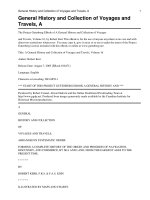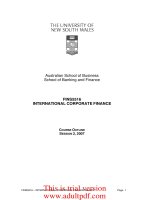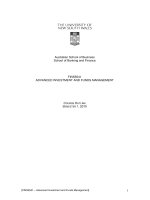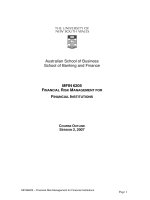modern business volume 16 banking
Bạn đang xem bản rút gọn của tài liệu. Xem và tải ngay bản đầy đủ của tài liệu tại đây (7.51 MB, 376 trang )
Jiw
,
o'-fl**-
'-
^
^
QfotncU
2Iltttoct0itg ffiihrary
Jlttfaca, Neta ^ntlt
SOUGHT WITH
THE INCOME OE THE
SAGE
ENDOWMENT
FUND
THE
GIFT OF
»
HENRY
W. SAGE
1891
To
renew this book copy the call
No.
and
give
to
the hbrarian.
;',,
^
HOME USE RULES
U
JUi
fviA"!
"<ii"o
tjji"
i3£S4 ;;; :(5i^g
|;^-fe=|^§^t#.
-
V
„.
^'
All Books
subject to Recali
All
borrowers must regis-
ter in
the library to borrow
books for
home use.
All
books must be rei
turned,
at end- of college
year
for
inspection
and
repairs.
Limited
books must be re-
turned within
the
four week
linut
and not renewed.
Students
must return all
books
before leaving town.
Officers
should arrange for
the return of
books wanted
during their
absence from
town.
I
Volumes
of periodicals
and of pamphlets are
held
in
the library
as much as
possible. For special ^pur-
poses they
are
given
out
foi
a limited
time.
Borrowers
should not use
their library privileges
for
the benefit
of
other persons.
Books of
special value
and gift books,
when the
giver
wishes it, are not
allowed
to circulate.
Readers
are asked
to
re-
port all cases
of bo<^u
marked
or mutilated.
Do not deface books
by
marks
and writing.
'
-^CorneU
University
Library
HG1586
.F75
Bankina
/
olin
S.^
Cornell University
wJM
Library
The original of tliis book is in
tlie Cornell University Library.
There are no known copyright restrictions in
the United
States
on the
use
of the text.
/>
A SERIES OF TEXTS PREPARED AS
PART OF THE MODERN BUSINESS
COURSE
AND SERVICE OF THE
ALEXANDER HAMILTON
INSTITUTE
ALEXANDER HAMILTON INSTITUTE
NEW YORK
Modern Blisiness
Editor4n-Chief
JOSEPH FRENCH JOHNSON
Dean, New
York University School of Commerce,
Accounts
and
Finance
Associate Editors:
PETER
P. WAHLSTAD,
ROLAND
P.
FALKNER
Titles Authors
Business and
the Man Joseph
French
Johnson
Economics OP Business
•
jaf.TcVeT"""
Organization and Control
Charles
W.Gerstenberg
Factory
and
Office Administration . .
Lee
Galloway
Marketing Methods
Ralph
Starr
Butler
Advertising Principles
Herbert
F.
De
Bower
Salesmanship and
Sales Management
. .
John
G.
Jones
Credit and the
Credit Man
Peter
P.
Wahlstad
Accounting Principles .
.
'
Thomas W. Mitchell
Cost
Finding
Dexter S. Kimball
Corporation
Finance William
H. Walker
Business
Correspondence
Harrison
McJohnston
Advertising
Campaigns
Mac
Martin
Railway Traffic
Edwin
J. Clapp
Foreign
Trade and
Shipping
Erich W.
Zimmermann
Banking
Major
B.
Foster
Domestic and
Foreign
Exchange.
.
. .
E.L.Stewart
Patterson
Insurance and
Real Estate
. .
/Edward
R. Hardy
(.Walter
Lindner
Merchandising
John
B.
Swinney
The
Exchanges
and
Speculation
Albert
W.
Atwood
Accounting
Practice
and
Auditing
. .
.
John
T.
Madden
Financial and
Business
Statements
. .
.
Leo
Greendlinger
Investment
Edward
D.
Jones
,
Business and the
Government
Jeremiah
W.
Jenks
BANKING
BY
MAJOR
B.
POSTER,
A.M.
Secretary
of
the
New York
University
School
of
Commerce,
Accounts
and Finance
MODERN
BUSINESS
VOLUME
16
ALEXANDER HAMILTON INSTITUTE
NEW
YORK
4-
EL
Ha
A.3?aiol
COPYBIGHT, 1918,
BT
ALEXANDER HAMILTON INSTITUTE
COPYRIGHT IN GREAT BRITAIIT, 1918, BT
ALEXANDER
HAMILTON
INSTITUTE
The
title
and
contents
of
this
volume,
as well as the business growing: out of
it, are further
protected
by
laws
re-
lating
to trade marks and
unfair trade.
All rights reserved, including' transla-
tion into Scandinavian.
Registered trade
mark, Reg.
V. S.
Pat.
Off.,
Marca
Registrada, M. de F.
Made in U. S. A.
i-V
PREFACE
The aim of
this volume
is to explain the
principles
of sound banking.
As
it is written primarily for
business men, it does
not contain a detailed
descrip-
tion
of
the inside
routine ^f a bank
but goes into
that
field only
so far as the customer
of
a
bank
needs to
go. The
banker
may get from
it some
help in solv-
ing the broad questions
of
policy
which
are,
after
all,
the most important. For
example
he may get new
light
upon
the
relations which
his bank should main-
tain with
customers and with
other banks in the coun-
try and
some new ideas as to
the
kinds
of
business
which
are safest and most profitable
for his type
of
bank
to undertake.
In
the
first
half
of
the volume
there
is an
explana-
tion of
fundamental principles. Then,
the
systems
tried
out
in early
American
banking and those now
existing
in Canada and in the chief countries of Eu-
rope are described briefly so that the reader may
see
how sound
and
fallacious
principles have been ap-
plied
and what the
results have been. Finally, the
Federal
Reserve
system is explained and analyzed
critically,
and some
of
the Wore important current
problems
in banking
are
discussed.
It
is
impossible to
mention in so
small
a
space
all
vi- PREFACE
those
who
have
made
it
possible for me to write
this
book.
Chief among my
teachers have been
Dean Jo-
seph French Johnson
of
the New York
University
School
of
Commerce, Accounts and
Finance, and Pro-
fessor
E. W.
Kemmerer
of
Princeton
Unive^sit5^
The National
City
Bank, The
Corn
Exchange
Bank
and The Broadway Trust Company, all of
New
York City,
have been extremely courteous and pa-
tient in giving
me helpful information.
I
am
in-
debted
to Mr.
B.
C.
Reese for
valuable
assistance
in
reading
proof and in research; and
I am
particularlj^
grateful
to
Mr. Howard
M.
Jefferson,
Auditor of
the
Federal
Reserve
Bank
of New York,
for
most of
the
material
on practical
banking.
Major B.
Foster,
New York.
TABI.E OF
CONTENTS
CHAPTER
I
CLASSES
OF BANKS
SECTION
PAGE
1. Primary Functions
of a Bank
1
2.
Secondary Functions
2
3.
Development
of Banking
2
4. Banks of Discount "
4>
5. Trust
Companies
5
6.
Sayings
Banks
6
7.
Savings and Loan
Associations
6
8.
Investment
Companies
8
9.
Industrial Banks
9
10. Land
Banks
10
11. Safe Deposit Company 12
12. Source
of Authority
13
13.
National Banks
14
14. Federal Reserve Banks
14
15.
Individual and Private Bankers
14
16. Choosing Your Bank
16
CHAPTER II
OPERATIONS
OP
A
COMMERCIAL BANK
,1.
Commercial Banks 18
2.
Capital
18
3.
Liability
of
Stockholders
20
4. Opening
for
Business
21
5.
Is
Capital a Liability.''
21
6.
A
peposit
^
22
vii
viii
BANKING
SECTION
PAQE
7.
A
Loan
22
8. A
Discount
23
9.
Undivided
Profits
24.
10.
Investments
24
11. Issuing Bank Notes 26
12. Other Transactions
27
13.
Bank Statement
27
CHAPTER III
THE BANK STATEMENT
1.
Purpose of a Bank
Statement
29
2.
Sample
Statement
30
3.
Changes in Bank Balance
Sheet
31
4.
Concealed Assets . .
32
5. Items in Resources
32
6.
Liabilities
:
Letters of
Credit
38
7.
London's Part
39
8.
Items
in Liabilities
40
9. Interpretation of a Bank
Statement
43
10.
Bank
Statement
Not
an
Infallible Indication
. 43
11.
Statement as an
Advertising Medium
44
CHAPTER
IV
LOANS AND
DISCOUNTS
1. Duration of Loans
47
2. Time Loans
48
3. Demand Loans
48
4. Call Loans
49
5. Kind of
Security
50
6.
Bank's
Title
50
7.
The Margin
51
8. Investment
Loans
52
CONTENTS ix
SECTION
PAGE
9. Industrial
Loans
53
10.
Capital Loans
.54
11.
Mortgage
Loans
56
12. Single
and
Double-Name
Paper
57
13. Acceptances
58
14. Loan
on Warehouse Receipts
60
15. Loans on Open Book Accounts
61
16. Loans on Insurance
Policies
62
17.
Loans on Chattels
62
18. Specialization
in Loans
63
CHAPTER V
ESTABLISHING
BANK CREDIT
1. Opening an
Account
65
2. The
First Loan
65
3.
Applying for a
Loan 66
4.
Making a Statement
i
. . .67
5. Knowledge of One's
Business 69
6.
Credit
Department 69
7.
Credit
Analysis
Rules
70
8.
Information
from Bank's
Records
76
9.
Dun's
and
Bradstreet's
77
10.
Trade Relations
78
11. Credit
Man's
Report
78
12.
Value and
Care
of Credit
79
13.
Kiting
79
14.
Overdue
Paper
80
15.
Overdrawing
81
16.
Uncollected
Funds
81
17.
Accommodation
Indorsement
82
18.
Inquiries at
the
Bank
83
X
BANKING
CHAPTER VI
BANK NOTES
SECTION
PAGE
1. Definition 86
2.
Evolution of the
Bank Note
87
3.
Cash Reserve
Against Notes 88
4. Security for Notes
.
90
5. Guarantee Fund 91
6.
Bond-Secured Notes
92
7.
Notes
Issued
Against Commercial
Paper
. .
93
8.
Notes
a
Preferred Debt
94
9.
Government Guarantee of Notes
95
10. Limit of Issue
.96
11. Other Forms of Regulation
98
12.
"Banking"
and
"Currency" Principles
. .
100
13. Elasticity
101
14.
Limited Elasticity
of Gold
101
15. Inelasticity
of Government Credit
Money . . 102
16.
How
Bank
Notes Can Be Made
Elastic
. . .
104
17. Profits
from
Issue
105
CHAPTER
VII
'
DEPOSITS
AND
CHECKS
1.
Special and
General
Deposits
110
2. Origin
of
Deposits
Ill
3. Reserve
Against
Deposits
112
4. Reserves
in the
United States
. .
.
.
.114
5.
Profits
on
Deposits
115
6.
Inducements
to
Depositors
116
7.
Should
Interest
Be
Paid
on
Deposits.? .
.
.118
8. Minimum
Balance
. .
120
9. Inter-Bank
Deposits
121
10.
Need
for a
Discount
Market
122
CONTENTS
xi
SECTION
^
PACE
11.
Guaranteeing
Deposits
124
12.
Deposits
Used as
Currency
125
13.
Need
for a
Central Bank
126'
14).
Relation of Business
Credit to
Bank
Credit
. .
127
CHAPTER
VIII
THE CLEARING
HOUSE
1.
Primary Functions
130
2.
An Illustration
131
3. New York Clearing
House
132
4.
Process of Clearing
132
5.
Settlement of Balances
137
6. r
Clearing
House Loan Certificates
. .
. .
138
7. Examination
of Members
140
8. Other
Activities
140
9.
Collecting Country
Checks
141
10. Boston Plan
142
11.
Significance
of Clearings
143
CHAPTER IX
BANK
ORGANIZATION AND
ADMINISTRATION
1.
Charter
146
2.
Board
of
Directors
147
3. President
148
4. Vice Presidents
149
5.
Cashier
150
6.
Chi^f
Clerk
150
7.
Auditor
151
8. Paying Teller
152
9.
Payrolls
153
10. Receiving Teller
154
11. Kinds
of
Indorsements
155
xii
BANKING
SECTION
^^^^
12.
Discount
Clerk
and
Note
Teller
156
13.
Bank
Bookkeeping
158
14). Figuring
Required
Reserves
159
CHAPTER
X
BANKS
AND
THE
GOVERNMENT
1.
Degree of
Control
162
2.
Capital
and
Surplus
Requirements
164*
3.
Stock Notes
165
4.
Restrictions
on
Loans
167
5. Usury
Laws
168
6.
Deposit Regulations
170
7.
Restrictions on
Note Issue
171
8.
Investments
172
9.
Examinations
and Reports
173
10.
Government Aid
174
11. Control
of Banking
in the United States
.
. . 175
CHAPTER
XI
AMERICAN
BANKING BEFORE
THE
CIVIL
WAR
1. Bank
of
North America
176
2.
Bank of
Massachusetts
177
3.
Bank of New
York
178
4.
Bank of the
Manhattan Company
179
5. First Bank
of the
United
States
180
6.
Second
Bank
of
the United States
. .
.
.183
7.
The
Bank
War
185
8.
Suffolk
System
187
9.
Safety-Fund
System
189
10. Free
Banking or Bond-Deposit
System
.
. 191
11. Indiana
and Ohio
193
12. Louisiana
194
CONTENTS
xiii
SECTION PAGE
13. Banking in Other
States
195
14.
George Smith's
Money 196
CHAPTER XII
BANKING IN
EUROPE
1. Bank of
England
199
2. Development of the Use of Checks 201
S. The Bank
and
the Government 201
4. Bank
Act
of
184-4
203
5.
Character
of
the Bank of England
Note . . . 204
6. A
Banker'.s Bank
205
7. A
Private
Institution
207
8.
Early Banking in Prance
209
9.
Bank of France
210
10. Meeting a Crisis 212
11. Selling Securities 213
12. Suspension of Specie Payment 215
13. Imperial Bank of Germany
.•
216
14.
Government
Control
217
15. Note Issue 218
16. Giro
System
219
17. Control
Over the Money Market
220
IS. Other
European Systems 221
CHAPTER XIII
CANADIAN
BANKING SYSTEM
1.
Banks and the
Government 223
2.
Note
Issue
224
S.
Emergency Circulation 225
4.
Central Gold Reserve
226
5.
Seasonal Fluctuations 227
6.
Security
of Bank Notes 229
xlv
BANKING
SECTION
PA«=
7.
Dominion
Notes
2^0
8.
Branch
Banking
2^1
9.
The
Line of
Credit
233
10.
Loans
on
Warehouse
Receipts
234
11.
Loans
on
Assignments
235
12.
Substitution
236
13.
Call
Loans
237
14.
Bank
Examinations
238
15.
Shareholders'
Audit
239
16.
Other
Financial
Institutions
240
CHAPTER
XIV
THE
NATIONAL
BANKING
SYSTEM
1. Origin of
the
National
Banking System . . .
242
2.
Secretary
Chase's Plan
243
3.
Early
History
of
the Act
244
4.
Comptroller
of the
Currency
245
5.
Summary of
the
National Banking
Act . . . 246
6.
Circulating
Notes
248
7.
Reserve
Requirements
.
249
8.
Development of Bank
Deposit Currency
. 250
9.
Seasonal
Demands
252
10.
Depletion
of
Reserves
253
11.
Inelasticity
254
12. Lack of Unity in
the System
256
13. Banks and the Federal
Treasury
256
14. Expedients of the
Secretary
258
15.
Maintenance of the Gold Standard
259
16.
Lack of Control Over the Money
Market
.
. 261
CHAPTER XV
BANKING REFORM IN THE UNITED STATES
1.
Defects of
the National Banking
System . . . 264
2.
Baltimore Bankers'
Convention
264
CONTENTS
XV
PAGE
3.
Proposals
of
Secretary
Carlisle
266
4.
Indianapolis
Monetary
Commission
267
5.
'
Gold
Standard Act of
1900
268
6.
Secretary
Shaw's Paternalism
270
7.
New York Chamber
of Commerce
Committee
. .
271
8.
American Bankers'
Association
Plan
273
9.
Aldrich-Vreeland
Act
274
10.
Aldrich-Vreeland
Notes
and the
Crisis of
1914
.
275
11.
Aldrich Plan
277
CHAPTER XVI
THE FEDERAL RESERVE
SYSTEM
1. Federal
Reserve
Act
280
2. Federal Reserve
Banks
281
3.
Control of Reserve Banks
284
4.
Federal
Reserve Board
284
5. Federal
Advisory Council .
. .
. . . 285
6.
Comptroller of the
Currency
286
7.
Secretary of the
Treasury
287
8. Bureau of
Audit and
Examination 288
9.
Division of
Reports
and Statistics
288
10. Operations of the
Reserve Banks 289
11. Powers
and
Duties of
the
Federal
Reserve Board 293
12. Operations
of
Member Banks
295
13. Loans on Real
Estate
297
CHAPTER
XVII
THE FEDERAL
RESERVE
SYSTEM
(^Continued)
1.
Reserves of
Member
Banks
299
2.
Combined
Reserves
^03
3.
Controlling the
Money
Market
304
4.
Federal
Reserve
Notes
307
xvi
BANKING
SECTIOS
PAGE
5.
Contraction
of
Federal Itesei-ve
Notes
. . .
309
6.
Reserves of
Federal Reserve
Banks
. . .
.311
7.
National
Bank
Notes
311
8.
Reserve
Bank Clearings
31
4<
9.
Advantages and
Disadvantages
of
the Clearing
Plan
317
10.
Gold Settlement
Fund
'
.
.318
,
CHAPTER XVIII
STATE
BANKS AND
TRUST COMPANIES
1.
Growth
of
State
Banks
320
2.
Trust Companies
322
3.
Danger of Trust Companies
324)
i.
State Banking
Legislation 324
5.
Incorporation 325
6.
Capital 325
7.
Supervision
327
8.
Real Estate Loans 328
9.
State Bank Failures 329
10. Relation to
Federal Reserve
System 330
11.
Legal Requirements
of State Banks 331
12.
Advantages Offered
332
13.
State Banks' Objections .
333
14.
Lack
of Clearness in the Law
334
15.
Collection
System
334
16.
Federal
Reserve
Board Regulation
336
17. State Laws on Membership
338
18. A
Satisfactory
Solution
Probable
339
I
BANKING
CHAPTER
I
CLASSES
OF
BANKS
1. Primary
functions
of
a hank.—The great metro-
politan
bank
of
today presents an appearance
of
mys-
tery
to the
ordinary
observer who
examines
it for the
first time. It has
so
many interests, its influence is so
far
flung and the
sums
in which it
deals
are so
large
that usually the
outsider despairs of ever understand-
ing it.
As
a matter of fact, the
essential
operations of
every bank,
whether large or
small, are
extremely
simple.
All that any
bank does is to
deal
in
credit.
Every
bank
exercises two
primary
functions, the ac-
cepting of
deposits and
the
making of
loans
or
dis-
counts.
A third
function
performed
by many
banks
is
that of issuing
notes
for
general
circulation as
a
substitute for
money.
These
are
the most
important
ways in
which a
bank
deals in
credit. In
each of them
the
bank
is always
exchanging
money
for credit,
or
credit
for
money or
credit for
credit.
A
bank,
then,
is an
institution
which deals in
credit
thru
the
accepting
of
deposits,
the making of
loans
XVI—
2
1
a
BANKING
and discounts and the
carrying out of other
related
operations which are
less
essential, such
as
issuing
notes, buying and
selhng
foreign
exchange,
etc.
De-
posits and discount (or
loans) are
the
essential
func-
tions,
Note issue is
important
but not
necessary
to
the business of all
banks.
About
one-fourth of the
b^nks in
the
United States
issue
notes, and of
all
the banks
in
the world even
a lower
proportion are
banks of
issue.
2.
Secondary
functions.
—
In
addition to
the
three
principal
functions—discount,
deposit
and issue
—
banks perform
various other services for
the
com-
munity. One important service is
advising
business
men on questions of finance.
A
growing
business
needs
more capital. Shall it
be
secured thru an
issue
of. bonds? If thru
bonds, what kind shall
be
issued?
Or, would it be
better to
issue
short-
term notes
or
ad-
ditional stock? How can capital be obtained most
advantageously? Under present conditions,
is it ad-
visable to
extend the business
to any great extent?
The
banker, with his knowledge of
the money
market
and of
general conditions, should
be
in
a
position
to.
give
valuable advice
on
such points
as these. Busi-
ness men
in
the
United States
do not
take advantage
of
this service as thoroly as they
might.
In
Canada
the
tie between business
men and
bankers is much
stronger.
3. Development
of
hanking.
—The
operations of
re-
ceiving
deposits and of
lending are
so simple that they
were
practised
by individuals long
before the estab-
CLASSES
OF BANKS
3
lishment of
regulaf banking
institutions.
The de-
mand for
these simple
services comes
early in every
growing
community. There
are people
who have ac-
cumulated savings and
want to
leave them
somewhere
for safekeeping, and there
are enterprising men who
see
golden opportunities in
business
if
they can find
the
funds with
which
to
finance
them.
As the business
life of
a
community
develops
and
becomes more
complex, the
banks in it find new
things
to
do.
At
first, the farmer borrows and leaves a
lit-
tle on deposit ;
the
merchant
sends in his cash for
safe-
keeping at the
close
of each day
and borrows to dis-
covint
his bills ; and the clerk
stores his savings
against
a
rainy day.
Gradually the bank
establishes itself in
the
confidence of
the people
until, after a
while, it is
called upon to
act as
trustee for
estates, give
credit
information, finance
new
developments and
exercise
many
of the
secondary
functions
of
banking.
All
the
work of
a
miniature trust
company,
savings
bank,
financial bank, commercial
bank
or
safe
deposit
com-
pany is
done under
one roof
until
finally
the
continued
growth of the
community
brings
specialization.
Then
separate
institutions are
organized to
carry
on
the
work
of
the
savings
bank,
trust
company,
etc.
In
the
larger
cities a
bank
today
is as
highly
specialized
as
any
other
organization
in the
business
world.
An
interesting
development of
more
modern
times
is the
grovpth of
mammoth
banks
in the
larger
cities.
Such
banks as
the
National
City
Bank
of New
York
and
the
Canadian
Bank of
Commerce
do
almost
every-









